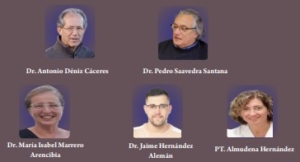Treatment of Spasticity in Patients with Brain Damage with the Association of Focused Shock Waves and Botulinum Toxin
Abstract | Volume 2 | Issue 2 | JRS Jul – Dec 2022 | Page 26 | Antonio Déniz Cáceres, Pedro Saavedra Santana, María Isabel Marrero Arencibia, Jaime Hernández Alemán ,Almudena Hernández
DOI: 10.13107/jrs.2022.v02.i02.65
Author: Antonio Déniz Cáceres [1], Pedro Saavedra Santana [2], María Isabel Marrero Arencibia [3], Jaime Hernández Alemán [4], Almudena Hernández [4]
[1] Rehabilitation Service, Hospital Universitario de Gran Canaria Dr. Negrín, Spain.
[2] Department of Mathematics, Universidad de Las Palmas de Gran Canaria, Spain.
[3] Department of Biochemestry and Molecular Biology, Universidad de Las Palmas de Gran Canaria, Spain.
[4] Universidad de Las Palmas de Gran Canaria, Spain.
Address of Correspondence
Dr. Antonio Déniz Cáceres, MD, PhD,
Rehabilitation Service, Hospital Universitario de Gran Canaria Dr. Negrín, Spain.
E-mail: antonio.deniz@ulpgc.es
Abstract
Introduction: Spasticity is a common complication in patients with brain damage secondary to stroke and multiple sclerosis, generating
disability and reducing the quality of life. In cases of muscles spasticity, we usually use Botulinum toxin injections (BTI) associated with
physiotherapy. Extracorporeal shock wave therapy (ESWT) is a safe, effective, and non-invasive treatment in these patients. Both methods are highly effective but currently are applied separately. Scientific evidence of the combined use of both techniques is scarce. The aim of this study is to assess the results of the association of both treatments (ESWT and BTI). On spasticity in patients secondary to stroke or multiple sclerosis.
Materials and Methods: This is a prospective study, with 6-month follow-up, including 10 adult patients with stroke or multiple sclerosis. ESWT was added to the usual treatment with BTI weekly for 3 weeks. The patients received rehabilitation during the treatment period and during the follow-up period. For statistical analysis in each of the follow-up weeks, the markers analyzed (spasticity and gait speed) were summarized in medians, which were plotted as a weekly function and the paired data were compared with the Wilcoxon test. The data were analyzed with an statistical program version 3.6.1 (R Development Core Team, 2019).
Results and Conclusions: We observed a statistically significant improvement in spasticity that was correlated with an increase in walking speed. The effectiveness of the combined treatment was superior and lasted longer than BTI alone.
Keywords: Shockwaves, Spasticity, Brain damage, Botulinum Toxin

| How to Cite this article: Deniz A, Saavedra P, Marrero I, Hernández J, Hernández A | Treatment of Spasticity in Patients with Brain Damage with the Association of Focused Shock Waves and Botulinum Toxin. | Journal of Regenerative Science | Jul – Dec 2022; 2(2): 26. |

Leave a Reply
Want to join the discussion?Feel free to contribute!